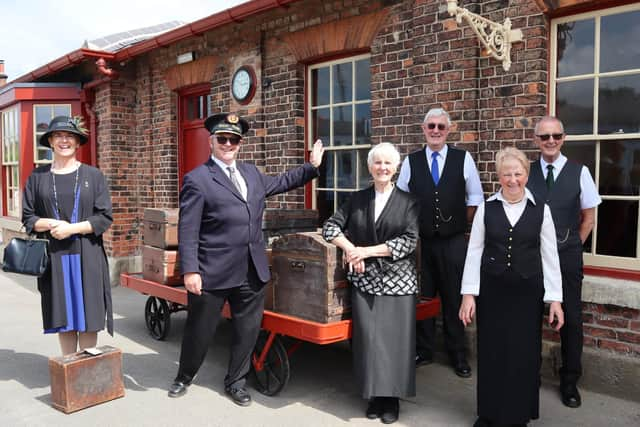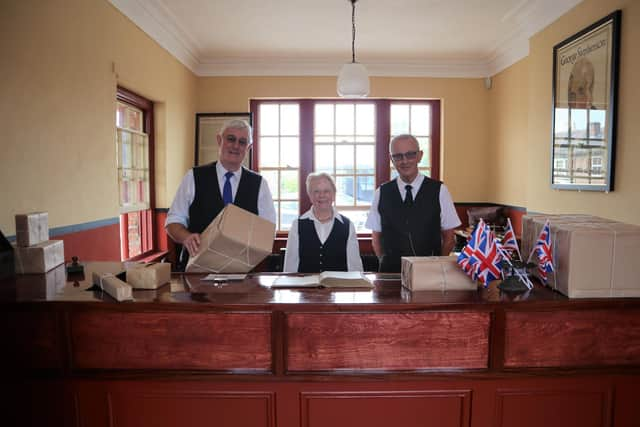Leeming Bar Station on the Wensleydale Railway to open fully to the public for the first time since 1954 after 1920s restoration
Leeming Bar was a victim of the mothballing of the Wensleydale Railway as a mainline, and though it re-opened to trains as part of the current heritage operation in 2003, passengers were never able to enter the Grade II-listed station house, which was used as offices and storage space.
Now following an injection of National Lottery funding, the parcels office, ticket office, waiting room and even the stationmaster's private accommodation have been restored to their 1920s heyday and will be fully accessible to visitors.
Advertisement
Hide AdAdvertisement
Hide AdThe long-running project, propped up by the hard work of volunteers, has even seen them track down original parts of the station apparatus that were thought to have been lost forever.


After the Wensleydale Railway successfully restored Scruton Station to its Edwardian, turn-of-the-century glory, they settled on the period immediately following World War One for Leeming Bar - though as community engagement officer Will Burnham points out, the roaring 1920s didn't shout too loudly in the rural Dales.
"The station has changed massively. Leeming Bar was tumbledown and in danger of falling to pieces. It was an admin hub of the railway, with offices for staff, but it wasn't publicly accessible and it had damp, no heating and was in a really sorry state. But it has so much history and you could see the character that still seeped through.
"We picked the 1920s because it was a period of massive change for the railways, with the line becoming part of the LNER in the new groupings. In future we plan to restore more stations to reflect other periods and show the passage of time."


Advertisement
Hide AdAdvertisement
Hide AdVolunteers performed a number of roles, from the painters and decorators to the cabinet-maker in his 80s who fitted an Edwardian kitchen using techniques taught to him by a man who had learned the craft in the Victorian age.
The research group pieced together information about the stationmaster and his wife, and their story will be incorporated into the visitor experience.
Yet the triumphs of the 'searchers' trawling Ebay and auctioneers for period pieces includes unique finds.
They managed to acquire the original leather cash pouches that had been used by Leeming Bar staff in the 19th century from an auction house, while a brass plaque commemorating the line's opening in the 1860s was also tracked down. The county council's records office helped to restore a large map of Wensleydale that will hang in the parcels office, and the owner of Wensley Station, which has been a private residence since the line's closure, donated the building's ticket equipment.
Advertisement
Hide AdAdvertisement
Hide AdItems from the period that came from other stations include ticket racks and labels from the late 1800s, telegraph machines, and the cast iron ticket grilles from Scruton that had been on display in a museum. Several rotten waiting benches from a station in Cumbria have been restored. Mangles, washtubs and cheese presses will be used in a functional stationmaster's kitchen, and a rare double-faced clock has been gifted.
"The parcels office is the most important room, and contains the stationmaster's desk. The ticket office will be the place where you still buy tickets today, and we have 1920s timetables on display. The waiting room has old luggage, posters and benches. These areas are what passengers in the 1920s would have seen."
However, a century ago they would not have been granted access into the stationmaster's family's private quarters, which include a parlour with William Morris wallpaper.
"These rooms still feel very Victorian, because the roaring 1920s were happening in London, not up here!"
Advertisement
Hide AdAdvertisement
Hide AdThe Leeming Bar restoration will officially be unveiled at a launch event on May 2.
"We have invited the community and we want to bring railway history to everyone. Often, heritage stops at the platform, but we want to bring people into the lives of the people who worked and lived here, the domestic side of things."
